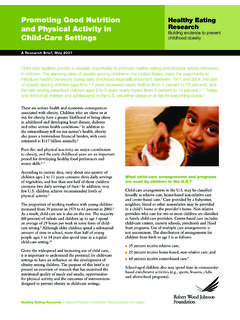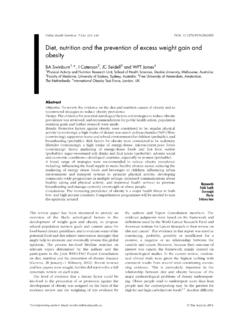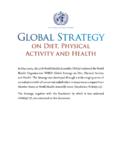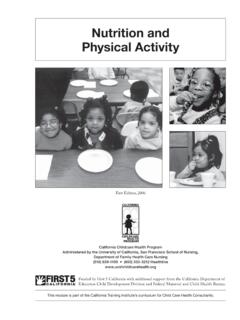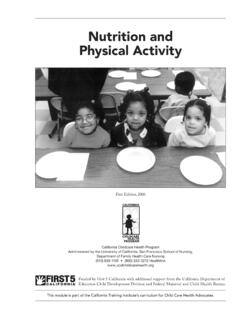Transcription of Nutrition and Physical Activity in Native Hawaiians and ...
1 Nutrition and Physical Activity in Native Hawaiians and Pacific Islanders A community and evidence-based perspective Archana J. McEligot Ka'ala Pang CSUF. Kawai Pang Juliet McMullin PIHP-Hawaii UCR. Charlene Kazner Ainahau O Kaleponi hawaiian Civic Club Objectives 1. Identify the community's Nutrition and PA challenges 2. Understand the health disparities for Pacific Islanders related to Nutrition 3. Familiarize the audience to Pacific Islander dietary intakes and needs 4. Discuss the social determinants/cultural context for diet and PA in Pacific Islanders 5. Characterize dietary interventions in Pacific Islander populations Our Values Pili Aloha M lama kekahi I kekahi Maihilahila Na'auao Ano ano hua Healthy Pacific Islanders Health problems aren't necessarily who NHPI.
2 Are, traditionally their diet, lifestyle and health conditions were excellent Healthy Pacific Islanders Source: Brittany Todd Healthy Pacific Islanders Discussion of weight, diet and exercise Weight as very unhealthy vs question of size Being able to do what you want to do. I see some very big Hawaiians , but they're still doing the things they want to do . It's the way you carry yourself . the emotion of being hawaiian Hula Warm-up Pressing Problems Objective 2: Health Disparities related to Nutrition and PA in NHPI. Some of the problems are well known and we know what we should do . Diseases Diabetes, heart disease, cancer Practices Diet and exercise Nutritious vs non-nutritious Fast vs home cooked hawaiian vs American What Are Our Health Disparities?
3 - Population According to the 2000 Census, there are 874,000 reported Native hawaiian and Other Pacific Islanders, which account for of the entire population 1. Native Hawaiians and Pacific Islanders, as a group, experienced growth between 2007 and 2008, third overall among race groups; Asians and Hispanics were second and first respectively2. Native Hawaiians are the largest Pacific Islander group in the followed by Samoan, and Guamanian or Chamoru. These three groups account for 74% of the total respondents who reported belonging to a single Pacific Islander group1. 1: Grieco, E. M. ( ). The Native hawaiian and Other Pacific Islander Population: 2000 (p. 1, Issue brief No. C2 KBR/01-14). doi: 2: Paisano, Edna L. We the American: Pacific Islanders.
4 Rep. Washington, DC: Government Printing Office, 1993. W. Department of Commerce Bureau of the Census, Sept. 1993. ( ) < >. From: White House Initiative on Asian Americans and Pacific Islanders Fact Sheet What Are Our Health Disparities? Native Hawaiians are over 5 times as likely to experience diabetes between the ages of 19 35 (11% vs. 2%) compared to non Hawaiians (Mau, Epi Reviews, 2009; Papa Ola Lokahi, NH. Epi Center Pub). Native Hawaiians have the highest rate of deaths due to cancer compared to any other ethnic group in Hawaii (229 per 100,000) and the 2nd highest rate in the country. (Chu KC, Cancer 2005). What Are Our Health Disparities? Pacific Islanders reported higher adjusted rates of hypertension ( ; , ), diabetes ( ; , ), asthma ( ; , ), and arthritis ( ; , ).
5 Pacific Islanders also more frequently reported having fair or poor health ( ; , ). Most differences in self-reported health status and chronic disease outcomes were mediated by higher rates of overweight and obesity, but not higher rates of smoking, among Pacific Islanders (Bitton, J Gen Intern Med. 2010). According to the CDC, Native Hawaiians and other Pacific Islanders have the second highest rate of diagnoses of HIV infection and the second shortest AIDS. survival rate of all Americans (Stafford, AJPH, 2010). Health in Children Source: Ethnic Health Assessment for Asian Americans, Native Hawaiians , and Pacific Islanders in California, August 2010. Among children, California schools use Healthy Fitness Zones (HFZ) to evaluate whether a student meets the HFZ goal of Physical Activity and body composition.
6 NHPIs reported the highest proportion of 5th graders whose Body Mass Index (BMI) are not in the HFZ, with Samoans ( ). and Other Pacific Islanders ( ) having the highest rates across all racial/ethnic groups. Guamanian ( ), Native hawaiian ( ), and Tahitian ( ) Californians also reported higher rates of 5th graders whose BMI are not in the HFZ compared to the state average (32%). More Samoan, Guamanian, Native hawaiian , and Tahitian children have a body mass index (BMI) not within the Healthy Fitness Zone compared to the state average. Demographics of DABS. 100. 90. 80. 70. % 60. 50. 40. 30. 20. 10. 0. Mean Age = 60. McEligot, McMullin, Pang, HMJ, 2010. What Are Our Health Disparities? Chronic Condition No 49% Yes 51%. McEligot, McMullin, Pang, HMJ, 2010.
7 Cardiometabolic Disease No Yes McEligot, McMullin, Pang, HMJ, 2010. Body Mass Index 8%. Normal 33% Overweight Obese 58%. McEligot, McMullin, Pang, HMJ, 2010. `A`ohe hana nui ke alu `ia (No work is too large when done by all). Objective 3. Familiarize the audience to Pacific Islander dietary intakes and needs Objective 4: Discuss the social determinants/cultural context for diet and PA. for NHPI. What Are We Eating? Major studies on Diet and Nutrition for NHPI. Wai'anae Diet Program, incorporated traditional hawaiian values with a Traditional hawaiian Diet (THD) of kalo (taro), poi (mashed taro), uala (sweet potato), fish and chicken (1 - 3). The PILI Ohana project, a CBPR partnership, conducted in Hawai`i encourages culturally-sensitive healthful lifestyle behavior change through various Nutrition and Physical Activity strategies (4), and results have shown reduction in weight and dietary fat intakes.
8 The Multi-ethnic cohort study, cross-sectional study between Hawaii and California assessing dietary intakes among five ethnic groups 1. Fujita R, Braun KL, Hughes CK. The traditional hawaiian diet: a review of the literature. Pac Health Dialog. 2004;11:250-9. 2. Shintani T, Beckham S, O'Connor HK, Hughes C, Sato A. The Waianae Diet Program: a culturally sensitive, community-based obesity and clinical intervention program for the Native hawaiian population. Hawaii Med J. 1994;53:136-41. 3. Shintani T, Beckham S, O'Connor HK, Hughes C, Sato A. The Waianae Diet Program: a culturally sensitive, community-based obesity and clinical intervention program for the Native hawaiian population. Hawaii Med J. 1994; 53:136-41. 4. Nacapoy AH, Kaholokula JK, West MR, Dillard AY, Leake A, Kekauoha BP, Palakiko DM, Siu A, Mosier SW, Marjorie KM; PILI 'Ohana Project.
9 Partnerships to address obesity disparities in Hawai'i: the PILI 'Ohana Project. Hawaii Med J. 2008 Sep;67(9):237-41. What Are We Eating? Mean Recommended Daily Allowance Whole Grain (serv) Refined Grain (serv) Vegetables (serv) 5. Fruits (serv) 5. Fiber (g) 25 - 30. Monounsaturated Fat (%). Polyunsaturated Fat (%). Saturated Fat (%) < 10%. Total Fat (%) < 30%. McEligot, McMullin, Pang, HMJ, 2010. Males (N=21) Females (N=34). Mean (SD) Range % Mean(SD) Range % above above guidelinesa guidelin ,b esa,b Food Intake Energy kcal 1882 (710) 992-3220 1601 (615) 579-3010. % Energy from fat ( ) 24 ( ) 22. Fiber, g ( ) 19 ( ) 12. Vegetable, servings ( ) 14 ( ) 3. Fruit, servings ( ) 14 ( ) 3. Whole grain, servings ( ) 5 ( ) 0. Refined grain, servings ( ) 66 ( ) 56.
10 Total Folate, mg 452 (204) 240-995 52 393 (285) 104-1781 35. Natural Folate, mg 265 (125) 123-609 19 204 (89) 123-607 3. Synthetic Folate, mg 187 (166) 46-853 5 190 (236) 23-1373 9. Vitamin C, mg 110 (92) 28-322 48 83 (53) 23-205 44. Vitamin E, IU ( ) 19 ( ) 18. Total carotenoids, mgc 10913 (6676) 1672-25118 8857 (6568) 487-25161. Calcium, mg 754 (459) 234-2433 10 714 (332) 129-1568 9. Iron, mg ( ) 100 ( ) 79. Supplement Intake Folate, mg 175 (246) 0-900 33 251 (309) 0-1000 44. Vitamin C, mg 168 (404) 0-1500 38 163 (330) 0-1060 26. Vitamin E, IU 94 (214) 0-833 43 65 (151) 0-667 47. Carotenoids, mgc 217 (598) 0-2550 1247 (6500) 0-38002. Calcium, mg 139 (272) 0-1120 0 367 (661) 0-2970 9. Iron, mg ( ) 10 ( ) 0-36 18. Bitton A.

